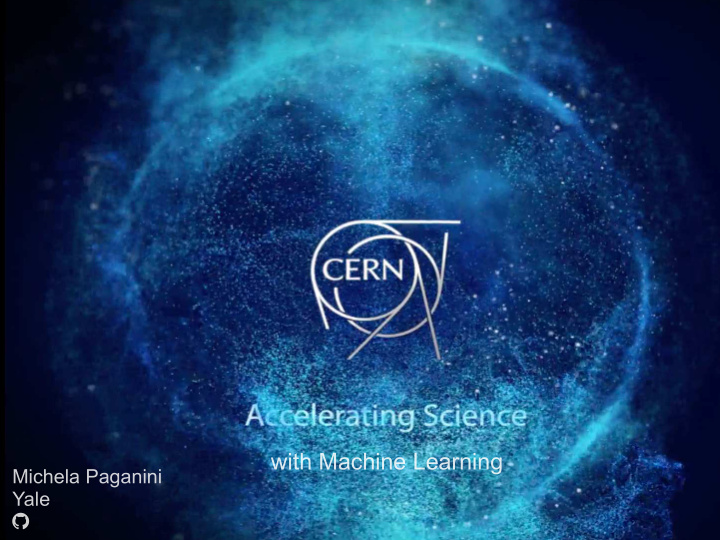



with Machine Learning Michela Paganini Yale � 1
Yale How does ML empower Physics at the LHC?
Yale Just like integration has helped theorists Just like statistics has helped experimentalists 2
It’s a tool!
Well… Like mathematics and statistics, machine learning is an entire field of research , both theoretical and experimental. But for us at CERN, for all intents and purposes, It’s a tool!
Yale The LHC generates ~1 billion collisions per second up to at 14 TeV (pp) and up to 1150 TeV (heavy ions) Lots of potential applications: - Data Analysis - Reconstruction - Trigger - Computing
Yale
Yale
Yale MOVE FASTER, PATCH THINGS THAT BREAK, ESTIMATE UNCERTAINTIES, AND COME UP WITH A PHYSICAL EXPLANATION FOR YOUR RESULTS
Yale Important Considerations for ML in HEP Performance: - improve upon traditional methods - save time and/or CPU Domain Specific Knowledge: - insert Physics knowledge to guide or constrain the net Interpretation: - favor simpler models - investigate what’s being learned and how throughout the layers - visualize inner activations and information propagation - learn from machine learning: helpful to design new physics variables Confidence: - need to estimate uncertainties
Yale Look how far we have come!
Yale We lack the software (or hardware) infrastructure for fast experimentation of state-of-the-art solutions Yet, growing challenges + By the time we started new young talents have caring, DL had already forced the various LHC exploded and created experiments to slowly join solutions that we can now t h e d e e p l e a r n i n g borrow to solve our revolution problems
Yale In certain cases, this search might fail — either no similar problems, or no applicable solution New ML solutions from physicists have been pushing the boundaries of ML Get the latest news from the CERN OpenLab workshop webcast!
Yale Recent Workshops and Conferences on ML in HEP NIPS Workshop 2014, 2015 DS@HEP 2015, 2016, 2017 Connecting the Dots 2016, 2017 IML Workshop CERN OpenLab workshop on ML and Data Analytics
From Daniel Whiteson, NIPS 2015 How far can we push it?
From Michael Kagan From Maurizio Pierini How Does Machine Learning Fit In? 15" • In analysis : – Classifying signal from background, especially in complex final states – Reconstructing heavy particles and improving the energy / mass resolution • In reconstruction : – Improving detector level inputs to reconstruction – Particle identification tasks – Energy / direction calibration • In the trigger : – Quickly identifying complex final states • In computing : – Estimating dataset popularity, and determining how number and location of dataset replicas From Jean-Roch Vlimant
Yale Analysis ++
Yale Jet Tagging Flavor tagging in ATLAS from track-based variables using Recurrent Neural Networks W boson and top tagging in ATLAS using high level features in BDTs and NNs Inclusive Flavor Tagging at LHCb
Yale Computer Vision Solutions to Jet Tagging Based on jet images Other References: L. G. Almeida, M. Backovi´c, M. Cliche, S. J. Lee and M. Perelstein, Playing Tag with ANN: Boosted Top Identification with Pattern Recognition , JHEP 07 (2015) 086 [1501.05968]. P. T. Komiske, E. M. Metodiev and M. D. Schwartz, Deep learning in color: towards automated quark/gluon jet discrimination , [1612.01551]. J. Barnard, E. N. Dawe, M. J. Dolan and N. Rajcic, Parton Shower Uncertainties in Jet Substructure Analyses with Deep Neural Networks, [1609.00607]. P. Baldi, K. Bauer, C. Eng, P. Sadowski and D. Whiteson, Jet Substructure Classification in High-Energy Physics with Deep Neural Networks , Phys. Rev. D93 (2016), no. 9 094034 [1603.09349]. Jet Images — Deep Learning Jet Constituents for Deep Neural Edition (Boosted W vs QCD) Network Based Top Quark Tagging
Yale Generation Bayesian Optimization for Event Generation Tuning GANs (Generative Adversarial Networks) for Fast Simulation: Other efforts with Variational Auto-Encoders Future attempts may include Autoregressive Models
Yale Computing From Virginia Azzolini From Filippo Tilaro From Andrey Ustyuzhanin
Yale Decorrelating Discriminants Dolan et al. arXiv:1603.00027 Physics-driven method - DDT (designing decorrelated taggers) Can we use an adversary? Louppe et al. arXiv:1611.01046 Shimmin et al. arXiv:1703.03507
Yale What’s next? Continue improving in areas such as: Tracking Calorimetry Anomaly Detection so much more!
Recommend
More recommend